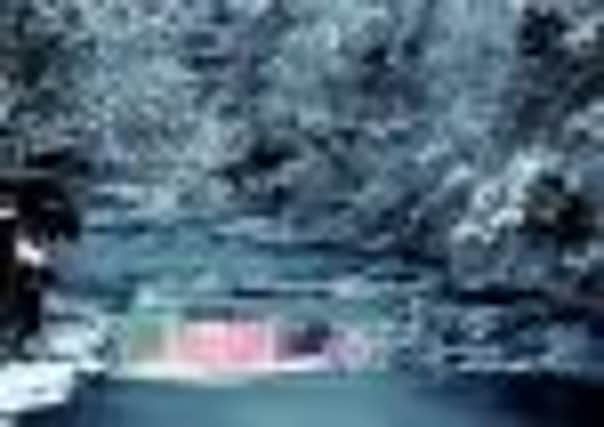Selling Scotland’s heritage down the river


OVER the holiday period, a steady stream made the short walk from New Lanark to the Falls of Clyde. They were among the 70,000 visitors from around the world who come to see the falls every year. All will appreciate the natural and dramatic beauty of the gorge, and many will know something of the rich historical importance of the area – that it has been visited, written about and painted by artists and poets such as Turner, Coleridge and Wordsworth – the latter “exceedingly affected by the solemn grandeur of the place”.
Many visitors will know exactly what he experienced. But very few of them will know that there is every chance that this “solemn grandeur” will be destroyed by the ambitions of Cemex, a multinational cement company that operates the nearby Hyndford Quarry. A planning application to extend quarrying to within yards of the Falls of Clyde is now expected to be submitted in February. Over a seven-year period the company wishes to extract four million tonnes of sand and gravel to the east of Corra Linn and to the north of Bonnington Linn, lowering the landscape by as much as 40 metres.
Advertisement
Hide AdAdvertisement
Hide AdThe area earmarked for quarrying is not only very close to the falls, it is also the heart of the “designed landscape” that was created by successive owners of the Bonnington Estate. The View House – an intriguing ruin located above Corra Linn – was built in 1708 and was the first building in Scotland to have been erected specifically for the enjoyment of nature. Visitors today will see an extraordinary undulating landscape, made up of the “kames” and “kettles” associated with the fluvio glacial deposits that make the area so attractive to Cemex. They will see the Wellingtonia trees within a parkland bounded by avenues of beech trees. These follow the route of the old drove road to Lanark still followed every June by Lanark’s Lanimer’s Day ride.
When, in 2000, Historic Scotland applied to Unesco for World Heritage Status for New Lanark it emphasised the historic importance of the surrounding area, stating that “the designed and natural landscape forms the setting and ambience of New Lanark and is intimately bound up with the value of the site”. The links between New Lanark and its setting are seen clearly in pictures that Robert Owen commissioned from the art teacher John Winning in 1818. New Lanark is portrayed firmly within the context of Corra Linn, the View House, and Bonnington House. One hundred and fifty years later, Alasdair Gray’s recently restored mural of the Falls of Clyde – which can be found in a restaurant in Kirkfieldbank – provides a mirror image of Winning by placing the Falls of Clyde and their surrounding parkland within the context of New Lanark and the town of Lanark.
That Cemex should even be contemplating submitting an application beggars belief – not least if one considers the plethora of protections that the area is supposed to enjoy. Historic Scotland included the area in the “buffer zone” of the New Lanark World Heritage Site. Anticipating the threat of quarrying, Historic Scotland said “there shall be a presumption against any proposal involving the winning and working of surface minerals by open-cast methods”. In the application signed by Scotland’s first First Minister, Donald Dewar, Unesco was assured that “the Council shall exercise strict control over development in order to ensure that such development as may be permitted will not adversely affect the landscape quality of the area”.
Current South Lanarkshire Council policies say that the area “will be protected, conserved and enhanced” and that “the council will not permit development that adversely affects the historical and typographical character and landscape quality”. On top of these protections, Historic Scotland entered the Bonnington Parkland into its Inventory of Designed Landscapes as recently as 2007 – a designation bringing with it another promise from South Lanarkshire Council that any development must “protect, preserve and enhance” the area.
Yet far from defending the area that they have done so much to promote, Historic Scotland has so far done much to indulge Cemex, a company that merrily blasted its way through an Aboriginal Heritage Place known to contain important rock art in Western Australia in 2008. In July 2010, Historic Scotland advised Cemex that “we do not in principle envisage your proposals detrimentally affecting the Outstanding Universal Value of New Lanark”. A year later, another missive from the body responsible for protecting Scotland’s heritage, dismissed concerns about Cemex’s application on the basis that the quarry “will not be visible from much of the actual World Heritage Site” and, in a breathtaking non-sequitur, that “extraction… will be for a limited time”. The protections promised in the application for World Heritage status a little over a decade ago are dismissed as being based on outdated planning policies, and the plan that superseded them “does not specify that quarrying should not be carried out within the designated buffer zone”. Neither does it specify that chemical weapon tests should be prohibited.
Aileen Campbell, MSP for the area, has assured constituents: “Historic Scotland are taking their role very seriously.”
But this role appears to be limited to assurances that that New Lanark will not lose its World Heritage Status. Historic Scotland risks losing sight of the fundamental issue – which is Scotland’s heritage. The planning policies that offer such unambiguous protections to the area are derived from the designations that reflect its natural, cultural and historic value.
Clinging on to New Lanark’s World Heritage Status whilst a quarry is ploughed through an area of “great landscape value” could hardly be construed as a triumph for Scotland’s heritage.
Indeed Historic Scotland’s myopic statements to date provide an eloquent case for ministerial intervention.
• Professor Mark Stephens is Chair of Save Our Landscapes